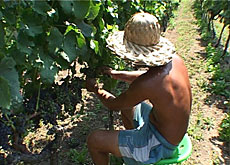Book traces Ticino and British culinary ties

The long culinary love affair between the British and the Italian-speaking Swiss of Ticino is the subject of a bilingual new book of history and recipes.
The book not only shows how Ticino became a popular holiday destination for the British, but also how the Ticinesi left an indelible gastronomic impression on London.
Ticino Foody – British and Ticinese Historic-Culinary Encounters is the brainchild of food journalist and bon viveur Alberto Dell’Acqua.
He came up with the idea to mark the 100th anniversary of the Anglican church in Lugano, which owes its existence to the British tourists of the 19th century.
The congregation of the Church of St Edmund the Confessor also provided the book’s 60 recipes, which range from traditional English favourites of Toad-in-the-Hole and Scones, to the more Italian-influenced Risotto and Linguine Sorrentina.
International dishes, such as Polish Beetroot and Chilli con Carne, are also featured.
Love
British tourists started coming to Ticino in the 1800s and fell in love with the region.
Among them was the great Romantic painter, William Turner (1775–1851), who painted the castles of Bellinzona, and art critic John Ruskin (1819-1890).
By 1825 English was already widely spoken in Lugano and luxury hotels began springing up in the town.
“With the inauguration in 1856 of the Grand Hotel du Parc (which became the Hotel Palace), a new era of tourism began in Lugano which was characterized by a strong presence of the British middle and upper classes,” says Dell’Acqua.
The high numbers of British tourists also brought about the need for an Anglican church in Lugano and the present one was founded in 1902, after an earlier building, a converted Catholic chapel, was abandoned due to flooding.
The dawn of tourism
The beauty of Lake Maggiore, particularly between the towns of Stresa and Locarno, also persuaded many travellers – who were usually en route to Italy – to stop over.
In 1851 the Hotel Corona in Locarno was marketing itself as the Great Crown Hotel, complete with bathing facilities and stabling for horses.
The town’s popularity was boosted further after the Grand Hotel opened in 1876. In addition to the mild climate of Lake Maggiore, guests appreciated the hotel’s excellent cuisine, French wines and first-class service, including beauty treatments – such as “wine therapy.”
The defining feature of the hotel was the magnificent lit Murano-glass chandelier in the entrance hall, at a time when electric light was still a great novelty.
Ticinesi invasion
But the 19th century was also a time that many Ticinese emigrated to Britain in search of a better life. Most of them were confectioners, cooks or waiters; others were craftsmen.
One key episode was the arrival in London in 1847 of Carlo Gatti, who came from the Blenio valley near Bellinzona.
Starting with nothing, he quickly established a chain of restaurants and his Gatti’s Royal Adelaide Gallery was regarded as the greatest restaurant of its day, with 40 cooks and 200 waiters.
In addition, Gatti introduced the famous penny ice – a cheap ice cream cone – and he was also instrumental in creating a new manufacturing process for ice, a forerunner of refrigeration.
Political success
Later the Gatti family was also to make their mark on local politics.
“The Gatti family left an important imprint on the history of Ticinese emigration by founding the Unione Ticinese in London in 1874,” writes Dell’Acqua.
“Another important mark was made by their descendent Sir John Gatti, who was elected mayor of London in 1920.”
Other success stories included Pietro Torriani, who opened London’s first confectionary shop with Swiss chocolate, as well as the capital’s first coffee shop, and Carlo Trabattoni, who later became personal cook to the Prince of Wales at Windsor Castle in 1885.
But Foody is much more than an account of the beginnings of high-class tourism and of how Ticinese immigrants fared in London, writes Dick Marty, the president of Switzerland Tourism, in his preface to the book.
“[It] shows us how a willingness between two cultures to meet and mingle can be a source of extraordinary enrichment and, at the same time, a healthy affirmation of the individual identity of each.”
swissinfo
1847 saw the arrival in London of Carlo Gatti. He was to have a profound influence on English eating habits.
In 1850 Pietro Torriani opened a confectioner’s, which was later transformed into one of London’s smartest restaurants.
In 1885, an immigrant from Ticino became personal cook to the Prince of Wales.
Foody is published in English and Italian by Fontana Edizioni and is written by Alberto Dell’Acqua.
The book also contains 60 recipes collected together by nutritionist Lulu Cerny.
Dell’Acqua is also the editor of the Gastronomie & Tourisme magazine.

In compliance with the JTI standards
More: SWI swissinfo.ch certified by the Journalism Trust Initiative












You can find an overview of ongoing debates with our journalists here . Please join us!
If you want to start a conversation about a topic raised in this article or want to report factual errors, email us at english@swissinfo.ch.